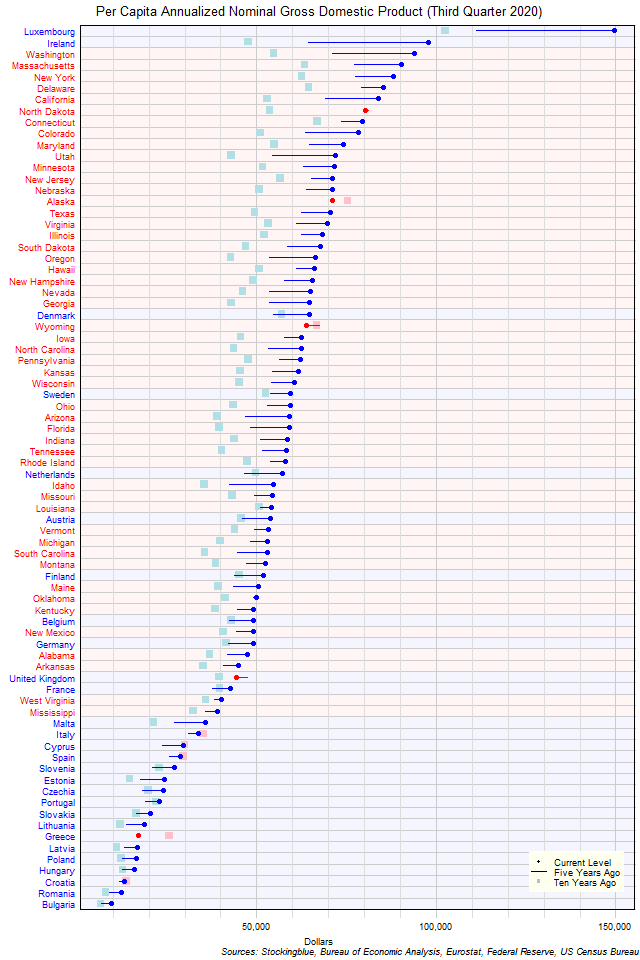
The chart above shows the per capita annualized nominal gross domestic product (GDP) in each EU and US state as of the third quarter of 2020 in dollars, the change from five years ago, and the GDP ten years prior. There are five states that have a lower per capita GDP now than they did five years ago and seven that have a lower per capita GDP now than they did ten years ago.
Findings
- The difference between the state with the largest per capita GDP, Luxembourg, and the state with the smallest, Bulgaria, is $139,995.74 (up from $104,407.48 five years ago and up from $95,908.78 ten years ago). Luxembourg and Bulgaria had the largest and smallest per capita GDP respectively both five and ten years ago.
- Luxembourg has 15.63 times the per capita GDP that Bulgaria does. The ratio of largest per capita GDP to smallest per capita GDP was down from 16.26 five years ago and up from 15.42 ten years ago.
- The median per capita GDP in the 28 EU states is $29,208.54 (up from $24,685.78 five years ago and up from $27,635.44 ten years ago) and the mean $38,764.05 (up from $31,638.39 five years ago and up from $31,369.79 ten years ago).
- The median per capita GDP in the 50 US states is $62,313.21 (up from $53,996.52 five years ago and up from $45,476.40 ten years ago) and the mean $63,666.08 (up from $56,321.56 five years ago and up from $47,408.45 ten years ago).
- The median per capita GDP in the 78 EU and US states is $57,568.56 (up from $49,358.10 five years ago and up from $43,096.53 ten years ago) and the mean $54,726.89 (up from $47,460.94 five years ago and up from $41,650.98 ten years ago).
- Of the 78 states, 73 (26 EU, 47 US) had a per capita GDP rise in current dollars over the past five years while 5 (2 EU, 3 US) had a per capita GDP drop.
- Of the 78 states, 71 (23 EU, 48 US) had a per capita GDP rise in current dollars over the past ten years while 7 (5 EU, 2 US) had a per capita GDP drop.
- Some EU drops in per capita GDP are attributed to currency rate fluctuations.
Caveats
- GDP data is from the third quarter of 2020, 2015, and 2010.
- US census data is from 2000 and 2010, EU census data is from 2001 and 2011.
- The data is seasonally adjusted in current dollars.
- Euros are converted to dollars at an average exchange rate of 1.17 for the third quarter of 2020, 1.11 for the third quarter of 2015, and 1.29 for the third quarter of 2010 according to historic rates listed at the Federal Reserve (see source link below).
- US data comes in an annualized format which the EU does not, thus EU data is annualized by multiplying the quarterly figure by four.
- US growth rates may differ from those provided by the Bureau of Economic Analysis as the BEA's growth rates are based on chained dollars in conjunction with the chain index or the quality index for real GDP. The growth rates listed here are based on nominal GDP.
- All figures are rounded to the nearest hundredth.
Details
In absolute terms, Wyoming had the worst performance over the past five years with a drop of $3,658.09. Luxembourg had the best performance with a gain of $38,314.68. Over the past ten years, Greece had the worst performance with a drop of $8,650.86 while Ireland had the best performance with a gain of $50,152.72.
In relative terms, the United Kingdom had the worst performance over the past five years with a 6.32% drop in per capita GDP while Ireland had the best performance with a 52.07% rise in per capita GDP. Over the past ten years, Greece had the worst performance with a 33.74% drop in per capita GDP while Ireland had the best performance with a 105.08% rise in per capita GDP.
There was one state (1 EU, 0 US) with a per capita GDP of over $80,000 ten years ago, 2 states (1 EU, 1 US) five years ago, and 8 states (2 EU, 6 US) now. On the flip side, there were 57 states (25 EU, 32 US) with a GDP of less than $50,000 ten years ago, 40 states (24 EU, 16 US) five years ago, and 28 states (21 EU, 7 US) now.
Utah (from 27th to 12th highest per capita GDP) rose 15 spots in the past five years, while Wyoming (from 10th to 27th) fell 17 spots. Over the past ten years, Utah (from 41st to 12th) rose 29 spots, while Wyoming (from 4th to 27th) and Louisiana (from 20th to 43rd) fell 21 spots.
Eight EU states surpassed 23 US states over the past five years. However, five EU states were surpassed by 14 states in the same time period. Over the past ten years, three EU states surpassed 20 US states while 10 EU states were surpassed by 42 states.
Sources
Eurostat. 2021. "GDP and Main Components." Accessed February 8, 2021. https://appsso.eurostat.ec.europa.eu/nui/show.do?query=BOOKMARK_DS-406779_QID_3C44FE83_UID_-3F171EB0&layout=TIME,C,X,0;GEO,L,Y,0;UNIT,L,Z,0;S_ADJ,L,Z,1;NA_ITEM,L,Z,2;INDICATORS,C,Z,3;&zSelection=DS-406779UNIT,CP_MEUR;DS-406779INDICATORS,OBS_FLAG;DS-406779NA_ITEM,B1GQ;DS-406779S_ADJ,SCA;&rankName1=UNIT_1_2_-1_2&rankName2=INDICATORS_1_2_-1_2&rankName3=NA-ITEM_1_2_-1_2&rankName4=S-ADJ_1_2_-1_2&rankName5=TIME_1_0_0_0&rankName6=GEO_1_2_0_1&sortC=ASC_-1_FIRST&rStp=&cStp=&rDCh=&cDCh=&rDM=true&cDM=true&footnes=false&empty=false&wai=false&time_mode=NONE&time_most_recent=false&lang=EN&cfo=%23%23%23%2C%23%23%23.%23%23%23.
Eurostat. 2017. "Population change - Demographic balance and crude rates at national level." Accessed December 11, 2017. http://appsso.eurostat.ec.europa.eu/nui/show.do?query=BOOKMARK_DS-054722_QID_690C8C0A_UID_-3F171EB0&layout=TIME,C,X,0;GEO,L,Y,0;INDIC_DE,L,Z,0;INDICATORS,C,Z,1;&zSelection=DS-054722INDICATORS,OBS_FLAG;DS-054722INDIC_DE,JAN;&rankName1=INDICATORS_1_2_-1_2&rankName2=INDIC-DE_1_2_-1_2&rankName3=TIME_1_0_0_0&rankName4=GEO_1_2_0_1&sortC=ASC_-1_FIRST&rStp=&cStp=&rDCh=&cDCh=&rDM=true&cDM=true&footnes=false&empty=false&wai=false&time_mode=NONE&time_most_recent=false&lang=EN&cfo=%23%23%23%2C%23%23%23.%23%23%23.
Federal Reserve. 2021. "Foreign Exchange Rates." Accessed February 9, 2021. https://www.federalreserve.gov/releases/g5/.
US Bureau of Economic Analysis. 2021. "GDP by State." Accessed February 5, 2021. https://www.bea.gov/data/gdp/gdp-state.
United States Census Bureau. September 2012. "United States Summary: 2010: Population and Housing Unit Counts." Accessed January 23, 2018. https://www.census.gov/prod/cen2010/cph-2-1.pdf.